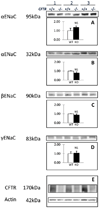Altered ion transport by thyroid epithelia from CFTR(-/-) pigs suggests mechanisms for hypothyroidism in cystic fibrosis
- PMID: 20729267
- PMCID: PMC2991370
- DOI: 10.1113/expphysiol.2010.054700
Altered ion transport by thyroid epithelia from CFTR(-/-) pigs suggests mechanisms for hypothyroidism in cystic fibrosis
Abstract
Subclinical hypothyroidism has been linked to cystic fibrosis, and the cystic fibrosis transmembrane conductance regulator (CFTR) shown to be expressed in the thyroid. The thyroid epithelium secretes Cl⁻ and absorbs Na(+) in response to cAMP. Chloride secretion may provide a counter-ion for the SLC26A4 (pendrin)-mediated I⁻ secretion which is required for the first step of thyroid hormonogenesis, thyroglobulin iodination. In contrast, few models exist to explain a role for Na(+) absorption. Whether CFTR mediates the secretory Cl⁻ current in thyroid epithelium has not been directly addressed. We used thyroids from a novel pig CFTR(-/-) model, generated primary pig thyroid epithelial cell cultures (pThECs), analysed these cultures for preservation of thyroid-specific transcripts and proteins, and monitored the following parameters: (1) the Cl⁻ secretory response to the cAMP agonist, isoprenaline; and (2) the amiloride-sensitive Na(+) current. Baseline short-circuit current (I(sc)) did not differ between CFTR(+/+) and CFTR(-/-) cultures. Serosal isoprenaline increased I(sc) in CFTR(+/+), but not CFTR(-/-), monolayers. Compared with CFTR(+/+) thyroid cultures, amiloride-sensitive Na(+) absorption measured in CFTR(-/-) pThECs represented a greater fraction of the resting I(sc). However, levels of transcripts encoding epithelial sodium channel (ENaC) subunits did not differ between CFTR(+/+) and CFTR(-/-) pThECs. Immunoblot analysis verified ENaC subunit protein expression, but quantification indicated no difference in expression levels. Our studies definitively demonstrate that CFTR mediates cAMP-stimulated Cl⁻ secretion in a well-differentiated thyroid culture model and that knockout of CFTR promotes increased Na(+) absorption by a mechanism other than increased ENaC expression. These findings suggest several models for the mechanism of cystic fibrosis-associated hypothyroidism.
Figures





Comment in
-
Thyroid glands from pigs with cystic fibrosis, old issues new ways.Exp Physiol. 2010 Dec;95(12):1131. doi: 10.1113/expphysiol.2010.055079. Exp Physiol. 2010. PMID: 21097980 Free PMC article. No abstract available.
References
-
- Alvarez de la Rosa D, Canessa CM, Fyfe GK, Zhang P. Structure and regulation of amiloride-sensitive sodium channels. Annu Rev Physiol. 2000;62:573–594. - PubMed
-
- Armstrong J, Matainaho T, Cragoe EJ, Jr, Huxham GJ, Bourke JR, Manley SW. Bidirectional ion transport in thyroid: secretion of anions by monolayer cultures that absorb sodium. Am J Physiol. 1992a;262:E40–E45. - PubMed
-
- Armstrong JW, Cragoe EJ, Jr, Bourke JR, Huxham GJ, Manley SW. Chloride conductance of apical membrane in cultured porcine thyroid cells activated by cyclic AMP. Mol Cell Endocrinol. 1992b;88:105–110. - PubMed
-
- Boucher RC. Airway surface dehydration in cystic fibrosis: pathogenesis and therapy. Annu Rev Med. 2007a;58:157–170. - PubMed
-
- Boucher RC. Cystic fibrosis: a disease of vulnerability to airway surface dehydration. Trends Mol Med. 2007b;13:231–240. - PubMed
Publication types
MeSH terms
Substances
Grants and funding
LinkOut - more resources
Full Text Sources
Medical

